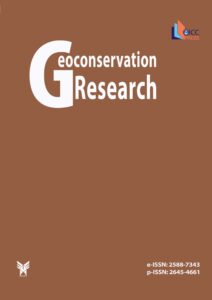Trace Fossils in Permian Rocks of English Riviera UNESCO Global Geopark
Authors
Abstract
The Permian breccias, conglomerates and sandstones of the English Riviera UNESCO Global geopark were deposited in quite harsh, desert environments just north of the Permian Equator. Body fossil evidence is completely lacking but rare trace fossils provide evidence of a land-based community. There is a variety of traces present, probably indicative of the presence of a range of unknown animals. Though these animals cannot be identified, their occurrence is important in the understanding of the biodiversity of these Permian environments.
Read the full text of the articleKeywords
Main Subjects
References
Allen JRL & Williams BPJ (1981). Beaconites antarcticus: a giant channel-associated trace fossil from the Lower Old Red Sandstone of South Wales and the Welsh Borders. Geological Journal. 16:255–269.
Benton MJ, Cook E, Turner P (2002). Permian and Triassic red beds and the Penarth Group of Great Britain. Geological Journal. 38(2): 190-190. https://doi.org/10.1002/gj.929
Bradshaw MA (1981). Paleoenvironmental interpretations and systematics of Devonian trace fossils from the Taylor Group (lower Beacon Supergroup), Antarctica. New Zealand Journal of Geology and Geophysics.24:615–652.
Chesle JT, Halliday AN, Snee LW, Mezger K, Shepherd TJ, Scrivener RC (1993). Thermochronology of the Cornubian batholith in southwest England: Implications for pluton emplacement and protracted hydrothermal mineralization. Geochimica et Cosmochimica Acta, 57: 1817–1835.
Clayden MA (1902). On the occurrence of footprints in the lower sandstones of the Exeter district. Quarterly Journal of the Geological Society of London. 64: 496–501.
Coram RA & Radley JD (2016). Devon’s desert ‘worms’. Geology Today. 32(2): 65–69.
D’Alessandro A & Bromley, RG (1987). Meniscate burrows and the Muensteria-Taenidium problem. Palaeontology. 30: 743–763.
Edwards RA & Scrivener RC (1999). Geology of the country around Exeter. Memoir for Geological Sheet 325 (England and Wales). London: HMSO
Falcon-Lang H (2019). Localities explained 22: South Devon, UK. Geology Today. 35(2): 73-80.
Gallois RW & Mather JD (2016). Trace fossils in the Permian rocks of South-West England. Geoscience in South-West England. 14(1): 20–28.
Graham TW & Pollard JE (1982). Occurrences of the trace fossil Beaconites antarcticus in the Lower Carboniferous fluviatile rocks of County Mayo, Ireland. Palaeogeography, Palaeoclimatology, Palaeoecology. 38: 257–268.
Hart MB (2012). The geodiversity of Torbay. Report and Transactions of the Devonshire Association for the Advancement of Science, Literature and the Arts. 144: 43–86.
Heer O (1877). Flora Fossils Helvetiae. Die vorweltliche Flora der Schweiz. J. Würster and Co.
Henson MR (1971). The Permo-Triassic rocks of south Devon. Unpublished PhD Thesis, University of Exeter.
Keighley D.G & Pickerill R.K (1994). The ichnogenus Beaconites and its distinction from Ancorichnus and Taenidium. Palaeontology. 37(2): 305–337.
Laming DJC (1969). A guide to the New Red Sandstone of Torbay, Petitor and Shaldon. Report and Transactions of the Devonshire Association for the Advancement of Science, Literature and the Arts. 101: 207–218.
Leveridge BE & Shail RK (2011). The marine Devonian stratigraphy of Great Britain. Proceedings of the Geologists’ Association. 122(4): 540–567.
Lima JHD & Netto RG (2012). Trace fossils from the Permian Teresina Formation at Cerro Caveiras (S. Brazil). Revista Brasileira Paleontologia. 15(1): 5–22.
Miller SA & Dyer CB (1878). Contribution to paleontology, No. 1. Journal of Cincinatti Society of Natural History. 1: 24–39.
Morrissey LB & Braddy S (2004). Terrestrial trace fossils from the Lower Old Red Sandstone, southwest Wales. Geological Journal. 47: 1–29.
Page KN (2004). A review of the geological heritage of Torbay with guidance for its management and a strategy for sustainable use. Torbay Heritage Forum. Retrieved from: http://englishrivierageopark.org.uk/documents/geologicalreview.pdf
Pengelly W (1864). On the chronological value of the New Red Sandstone System of Devonshire. Report and Transactions of the Devonshire Association for the Advancement of Science, Literature and the Arts. 1: 31–43.
Perkins JW (1971). Geology explained in South and East Devon. David and Charles, Newton Abbot.
Pollard JE (1976). A problematic trace fossil from the Tor Bay Breccias of south Devon. Proceedings of the Geologists’ Association. 86: 105–108.
Ridgeway JM (1974). A problematical trace fossil from the New Red Sandstone of Devon. Proceedings of the Geologists’ Association. 85: 511–517.
Ridgeway JM (1976). A problematic trace fossil from the Tor Bay Breccias of south Devon. Written discussion of a paper taken as read, reply by the author. Proceedings of the Geologists’ Association.86: 108–109.
Schneider JW, Lucas SG, Werneburg R, Rößler R (2010). Euramerican late Pennsylvanian/early Permian arthropleurid/tetrapod associations – implications for the habitat and paleobiology of the largest terrestrial arthropod. In Lucas SG. et al. (eds), Carb-Permian transition in Cañon del Cobre, New Mexico Museum of Natural History and Science Bulletin. 49: 49–70.
Seilacher A (1953). Studien zur palichnologie. I. Uber die methoden der palichnologie. Neues Jahrbuch für Geologie und Paläontologie, Abhandlungen. 96: 421–452.
Selwood EB, Edwards RA, Simpson S, Chesher JA, Hamblin RJO, Henson MR, Riddols BW & Waters RA (1984).Geology of the Country around Newton Abbot. Memoir for 1:50,000 geological sheet 339. HMSO, London.
Shapter T (1842). The climate of south Devon; and its influence upon health; with short accounts of Exeter, Torquay, Babbacombe, Teignmouth, Dawlish, Exmouth, Budleigh Salterton and Sidmouth.London: John Churchill.
Ussher WAE (1877). The age and origin of the Watcombe Clay. Report and Transactions of the Devonshire Association for the Advancement of Science, Literature and the Arts. 9: 296–300.
Vialov OS (1962). Problematica of the Beacon Sandstone at Beacon Height West, Antarctica. New Zealand Journal of Geology and Geophysics. 5: 718–732.




